A spirit decanter’s chief purpose is to beautify the liquid, in-so-doing raising the expectation of the drinker. The style and quality of the vessel deployed might show something of the personality and wealth of a host, underlining their sense of generosity. When a decanter emerges, it emphasises the sense of occasion: this moment is an upgrade; a reward. Conversely, for a mean mine host, a classy-looking decanter momentarily at least can conceal a lower quality drink. To quote Terry Pratchett, ‘It’s a sad and terrible thing that high-born folk really have thought that the servants would be totally fooled if spirits were put into decanters that were cunningly labelled *backwards*. And also throughout history the more politically conscious butler has taken it on trust, and with rather more justification, that his employers will not notice if the whisky is topped up with eniru.’
Material Advantages
Weightier than a bottle, the heftier nature of a spirits decanter makes it harder to topple and therefore smash, protecting its contents and saving a host or their guest ‘face’. Unlike wine, spirits do not benefit from aeration, though a close-fitting stopper will usefully guard against the ingress of unpalatable aromas. Nor does a spirit need racking from bottle to decanter to rid it of coarse sediment. Lacking staining tannins, a spirit, therefore is kinder to a decanter, which stays clearer than if a rich red wine or vintage Port soaks within.
From Roman Times to Today
While decanters date from the Romans, several of today’s familiar shapes often have grounding from the Renaissance and the rise of the Venetian empire. According to British designer, Richard Brendon, whose work is often inspired by pieces from the seventeenth and eighteenth centuries, the modern spirit decanter became ubiquitous as a reaction to the unappealing looking bottles and, tainting of flavour, rudimentary casks in which spirits were packaged. ‘Bottles several hundred years ago would have been unattractive, so wouldn’t have been displayed to guests, or they would have purchased spirit by the barrel so needed something to decant into for serving,’ he says.
Mirror Image
Realising the covetable, aesthetically impactful nature of the decanter, aspirational spirit brands have incorporated decanter design cues into their packaging. These range from the slightly kitsch of gold-accented label, Artingstall’s Brilliant London Dry Gin from ‘Last Christmas’ film director, Paul Feig, which is square with a diamond shaped stopper, to the over-elaborate, prickly, Louis XIII Cognac bottle which, when full, approaches 5kg, and is handblown at the Baccarat crystal-works. Consigning either empty to the recycling bin would be, respectively, sad, and ruinous, meaning each will continue to exist, as a vase or a decanter for another drink, as a form of advertising long since the last drop of distillate has been drunk.
From quirky and affordable to minimalistic, colourful, ‘punk’, and classic and sheerly priced, here are some of the most impactful options on the market.
Best for quirkiness:
Globe (£30, MenKind)
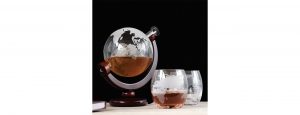
Etched with a world map, the gimbled globe with ball stopper can be gently spun on its cradle to show the different continents. Gilding the lily, a glass galleon within emphasises, forgive the pun, the spirit of adventure and encourages the drinker to fill it with something out of the ordinary.
Best for relevance:
Angels’ Share Glass Pot Still (£48, Harvey Nichols)

Taking the name of the whisky regrettably lost from barrel to evaporation during maturation, the ‘Angels’ Share’ decanter eccentrically evokes a pot still replete with whisky-hued stopper which recalls the swan neck of a still. It was created by Tom Young MBE and daughter, Karen in their glass blowing studio in Bridge of Allan, north of Stirling in Scotland’s Lowlands.
Best for simplicity:
NUDE Malt Whisky Bottle (£97, nunido)
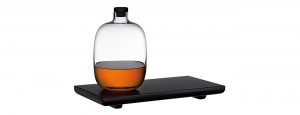
This bravely stripped-back flask was conceived in collaboration with Finnish designer, Mikko Laakkonen. According to head of NUDE, Asli Aydogan. ‘we reworked the traditional whisky decanter into a sleek minimalist set defined by clean lines and sweeping curves.’ Referring to Finland’s pine forests, the carafe sits on a smooth wooden plane.
Best for alfresco:
Colourful Whisky Set (Tall) (£129.99, Knead This)
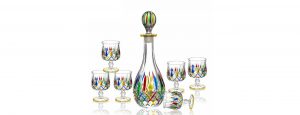
From minimal to maximal, resembling the colourful glass of Murano, this flamboyant, hand-enamelled decanter from Wuhan evokes a precious teardrop and brings particular personality to clear spirits. I suspect it could best work in the sunny outdoors, capturing sunlight, causing a rainbow of reflections on the table.
Best for breaking boundaries:
Nachtmann Punk (£150, Nachtmann)
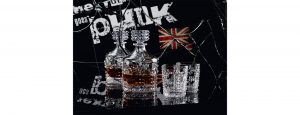
Intended as ‘a juxtaposition between luxury and Punk’ by ceramicist, Anke Buchmann, this set celebrated the fortieth anniversary of Punk culture. Not unlike a highway rumble strip, each time the drinker encounters the raised studs on both ‘punky’ decanter and tumblers, they are reminded to pay attention to the liquid within.
Best for night:
Waterford Lismore Black Square (£268, Kings and Queens)

In contrast to the shimmering clear crystal, Waterford of Ireland’s traditional Lismore pattern has been given shiny black accents to emphasise the deep cuts of the design. Particularly decadent for after dinner moments.
Best for modern living:
Richard Brendon, Fluted Cut Crystal (£295, Richard Brendon)
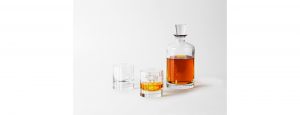
‘I wanted to create something that used the traditional glassblowing methods with a firm nod to the past, but in a modern manner to make it more relevant to today’s style and taste,’ says designer, Richard Brendon of the cleanly cut, Fluted decanter. His wares are incidentally rejoiced in the ‘Book of Berries’ cocktail menu at Gleneagles.
Best for craft:
Whiskey decanter and glasses by Michael Ruh (£530, The New Craftsmen)

Glass artist, Michael Ruh loves this set’s sense of directness. ‘Its unadorned purpose, to bring us together for a drink and a chat,’ he says. On closer inspection, abstract lines become visible. ‘A process of incising into the near-finished shape when the glass is hot,’ he says, ‘similar to Bokuseki calligraphy because lines must be applied boldly and assertively – there can be no error as the glass records all…’
Best for beauty:
Lalique Wingen (£860, Amara)

From an unforced design to a consistently structured, statuesque decanter, the ‘Wingen’ decanter is named after Wingen-sur-Moder, the Alsace village where Cristallerie Lalique is based. Leading the eye, the rising design evokes an even more rarefied Lalique crystal decanter, ‘The Trinity Provenance’ which encapsulates a 33-year-old single malt from Lalique’s recently acquired distillery, The Glenturret, which features a crystalware boutique. The latter rendition can be yours for £9,800!
Best classical decanter:
Harcourt Empire (£1,100, Baccarat)

Created in 1841, Harcourt is the oldest service in the Baccarat inventory. Hand-applied to each flat cut are gold motifs, leading to a bevelled, diamond cut stopper atop a Pagoda like spout. And here is a factoid: the Baccarat factory runs 24 hours a day to maintain the temperature of the furnaces.







